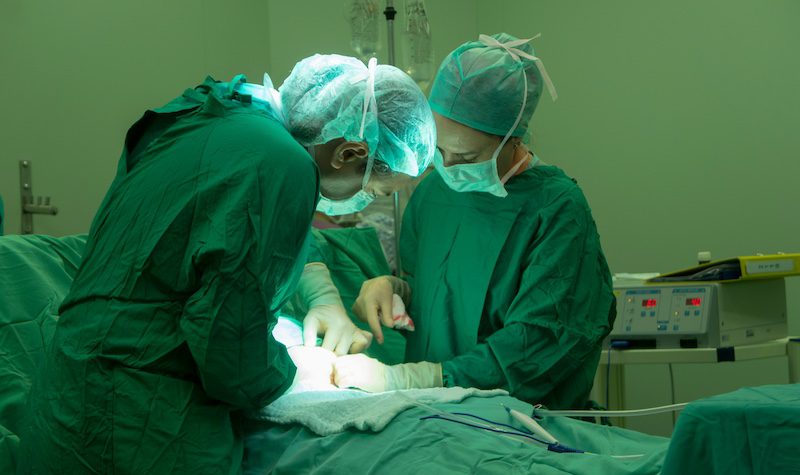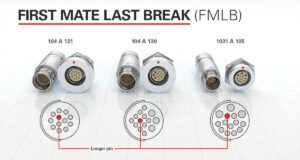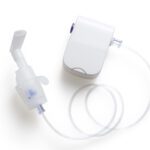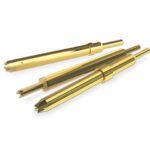First Mate Last Break Connectors Boost Safety and Reliability
A surgical device manufacturer needed a connector with a mixed configuration of power and data contacts to pair with a 12-foot silicone overmolded cable assembly, making autoclave sterilization difficult. FMLB connectors met the challenge.

To choose the best connector for a medical device, a designer must move through a maze of often conflicting requirements. A mechanically suitable component must meet regulatory requirements, endure sterilization processes, stand up to thousands of mating cycles, and deliver electrical safety, signal integrity, and mechanical reliability despite the rigorous conditions of clinical or surgical environments. It can be difficult to find one that does it all.
MicroAire Surgical Instruments’ designers faced such a challenge to specify connectors for its Power-Assisted Liposuction (PAL) System. The manufacturer needed a connector with a mixed configuration of power and data contacts to pair with a 12-foot silicone overmolded cable assembly — a package that made sterilization unwieldy.
Nick Sklavos, staff electrical product development engineer at MicroAire, said the right connector must be, first and foremost, sealed and robust. “The device is used in surgical procedures and needs to be autoclaved. The handpiece must have a fully sealed and potted connector to prevent moisture and steam from penetrating through the PEEK insulating material inside the instrument. It must also have gold-plated contacts and be rust-proof.”

First Mate Last Break
The MicroAire team selected Fischer Connectors’ Core Series low-voltage multipole connectors with a mixed configuration of power and data contacts, in compliance with IEC 60601-1. The solution’s first mate last break (FMLB) interconnects add an additional layer of safety between the handheld device, console, and pedal. FMLB connectors establish a ground connection before other signals come into electrical contact when a device is plugged into a console or power source. When it’s time to disengage, the ground connection – which is a bit longer than the other pins — remains after the other terminals have separated. It is the first contact to mate, and the last to unmate, or break.
“We want the ground of the cable to be always on, to mate first, so the system is within a ground presence all the time, and to break last, for signal integrity and electrical safety reasons,” said Sklavos. “Without the presence of ground, we have floating signals which, from a signal integrity point of view, might cause numerous electrical artifacts that are impossible to predict (crosstalk, capacitive coupling, EMI problems, etc.), in addition to risky electrical safety conditions.”
To maintain compliance with the IEC 60601-1 technical standard medical electrical equipment, MicroAire had to meet stringent electrical safety requirements with the PAL System, as well as signal integrity reliability. The longest pin of the Fischer Core connectors used in the PAL System (see red dot in image below) establishes the ground path before the other power or signal connections are made. The longer contact of the handpiece cable plug (or pedal cable plug) also breaks last when unmating.

MicroAire’s PAL console features two receptacles that mate first and break last with the handpiece cable plug’s longer pin. The FMLB receptacle of the pedal control is installed between the two instrument receptacles.
Customization
MicroAire also needed a level of customization to ensure flexibility in its device designs. “The connectivity partner for medical device manufacturers must be open to customization, because medical regulations change a lot. And the company must meet some clauses from the FDA,” said Sklavos. One important clause to factor in the design is creepage. Creepage affects the ability of the product’s insulation to withstand high voltages and prevent arcing. IEC 60950 and UL 60950 specify strict creepage requirements. “With Fischer Connectors, we agreed to create a plastic border inside the connector,” said Sklavos. “When the two mate, from either side, from the PAL console side and the handpiece side, this border protects the other shell (which is metal) from ESD zapping.”
A rugged choice
MicroAire’s collaboration with Fischer Connectors encompasses other medical devices, such as orthopedic tools like drills, wire drivers, and surgical burrs. Fischer provided interconnects that can endure the autoclave requirements of medical devices, a challenge not all last mate first break products can meet. “One company hadn’t done any autoclave testing, another claimed 100 autoclave cycles, which wasn’t enough. Another good connector manufacturer could meet both the creepage and autoclave requirements but couldn’t deliver the connectors in time, and they couldn’t offer the customization that design engineers need. Only Fischer Connectors could make the connection with the customization we needed.”

The Fischer Core first mate last break connectors in size 104 (15 mm diameter plug) used in the PAL System, as part of a 12-feet silicone overmolded cable assembly, are IP68 sealed and have a potted back. The assembly is resistant to autoclave sterilization and corrosion, and the connectors can withstand 10,000 mating cycles.
Pin size supports the ruggedness and reliability of the medical device. Thick pins ensure that contacts can withstand the rigors of use and robust cleaning, including hand scrubbing with brushes, as this surgical instrument tends to get contaminated with blood and fat. (The PAL console is located a few meters away from the surgical site.) To protect the connection, thicker pins offer better durability. The PAL System’s handpiece uses Fischer Core 104 A 130 connectors with 14 pins: 3 large 0.9 mm power contacts for a maximum current of 9.5 A, and 11 0.5 mm data contacts (including a longer contact for ground in FMLB) for 5 Gb/s Ethernet. The 104 A 131 connectors used for the pedal connected to the console feature 12 power and data contacts of 0.5 mm (including the longer ground/FMLB contact) for 4.2 A and 5 Gb/s Ethernet. On the console side, the pin size was enlarged from 0.5 to 0.7 mm for robustness.
Keying and locking options
Before MicroAire’s technical team opted for the Fischer Core Series first mate last break option, “users of the PAL System would try to plug the connector in different ways and break the pins,” said Sklavos. “With the very robust keying provided by Fischer Connectors for our new unit, the plug can’t go inside any other way, only the right way.” The connector features an ultra-robust double keying system with two metal plates or arcs, one up and one down, which prevent users from forcing it in incorrectly and damaging the system.
“Our highly customizable Fischer Core product line is well-known for its versatility,” said Ray Benson, Fischer Connectors regional sales manager. “It offers not only a large variety of contact configurations, sizes, and materials, but also different types of locking mechanisms: push-pull, tamperproof, quick-release and friction fit. The one chosen to meet MicroAire’s requirements for the PAL System’s handpiece is a push-pull.”
The push-pull connector that goes into the handpiece remains securely in place once connected, preventing accidental disconnection when the user shakes and holds the handpiece vertically during surgery or set-up. “It is both rugged and locked, and to unlock it, you have to make an effort,” said Sklavos.
The console, however, uses a non-locking connector, said Sklavos. “If the connector locks, people don’t know how to unlock it. They don’t know you have to pull on the shell and then on the connector. So, people try to unplug it, and twist it — and they damage it. If the console is locked, when a user pulls on the cable or a cart passes by and pulls it, they will pull the console too, which may fall to the floor.”
Benson said specifying a non-locking connector for the side of the console is the best solution. “If someone pulls on the cable, it will pop out,” he said. “The connectors had to be easy to mount on the handpiece to ensure a user-friendly and secure connection,” Benson said. “The surgeon or nurse brings the cable and simply plugs it in, then takes the other end and plugs it into the console. The feedback we’ve received so far has been excellent. Surgeons and nurses appreciate the robustness of the connectors, their ease of use, and the smoothness of the friction fit.”
Learn more about Fischer Connector’s solutions for medical devices.
Like this article? Check out our other Connector Basics articles, our Medical Market Page, and our 2023 and 2024 Article Archives.
Subscribe to our weekly e-newsletters, follow us on LinkedIn, Twitter, and Facebook, and check out our eBook archives for more applicable, expert-informed connectivity content.





